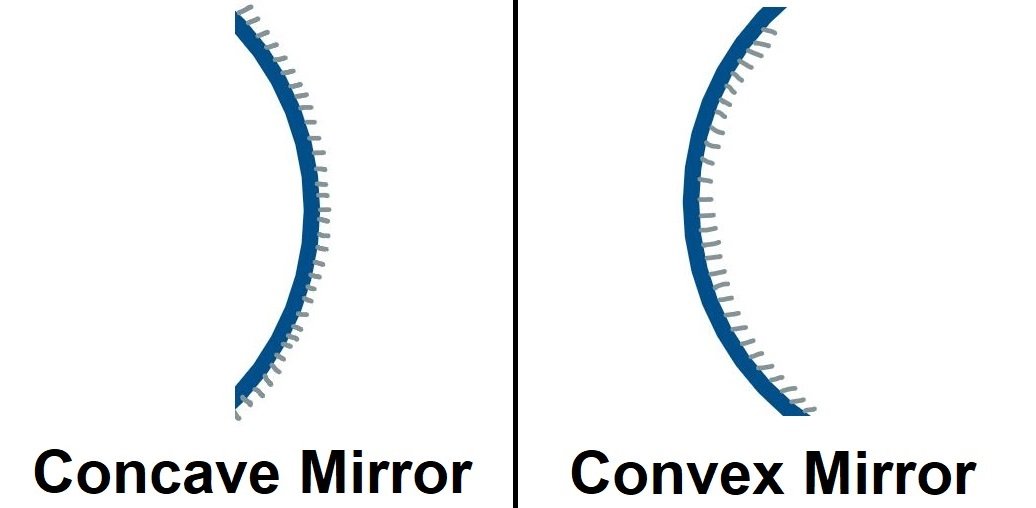Mirrors, ubiquitous in our daily lives, serve a vital purpose beyond merely reflecting our appearances. They come in various shapes and forms, each with unique properties that influence the way light behaves. Among the diverse mirror types, concave and convex mirrors stand out due to their distinct characteristics and applications. In this article, we delve into the fundamental difference between concave and convex mirror types, shedding light on their behaviors, uses, and underlying principles.
I. Understanding Concave Mirrors
Concave mirrors, with their curved reflective surfaces that curve inward, are intriguing optical devices. The curvature causes light rays parallel to the mirror’s principal axis to converge, creating a focal point. This focal point, often referred to as the “focal point of a concave mirror,” is a key attribute that distinguishes concave mirrors from their convex counterparts.
A. Focal Length and Image Formation
The focal length of a concave mirror, denoted by “f,” is the distance between the mirror’s focal point and its center of curvature. This distance plays a crucial role in determining the mirror’s ability to form images. When an object is placed beyond the mirror’s focal point, a real and inverted image is formed between the focal point and the mirror’s surface. On the other hand, if the object is positioned between the focal point and the mirror, a virtual and upright image emerges on the same side as the object.
B. Applications of Concave Mirrors
The distinctive properties of concave mirrors find applications in various fields. One of the most notable applications is in telescopes, where these mirrors are employed to capture and focus distant light, enabling astronomers to observe celestial objects with enhanced clarity. Additionally, concave mirrors are utilized in makeup mirrors, headlights of vehicles, and reflective solar concentrators that harness sunlight for energy generation.
II. Exploring Convex Mirrors
In contrast to concave mirrors, convex mirrors feature outward-curving reflective surfaces. The curvature of these mirrors causes light rays parallel to the principal axis to diverge. Interestingly, the focal point of a convex mirror is a virtual point that appears to be behind the mirror, which is a significant departure from the behavior of concave mirrors.
A. Wide View and Reduced Image Size
Convex mirrors are known for their ability to provide a wider field of view compared to other mirror types. Due to the divergence of light rays, convex mirrors can reflect a larger area, making them useful in scenarios where observing a broad area is more critical than capturing fine details. However, this wider perspective comes at the cost of image size reduction. Objects reflected in a convex mirror appear smaller than their actual size.
B. Practical Applications
The unique characteristics of convex mirrors find applications in several practical contexts. One notable example is their use in safety mirrors, commonly seen in retail stores, parking lots, and driveways. These mirrors allow individuals to observe a larger area and anticipate potential hazards, enhancing overall safety. Convex mirrors are also employed in car side mirrors, enabling drivers to have a wider view of their surroundings and minimize blind spots.
III. Key Differences and Similarities
While concave and convex mirrors differ significantly in their behaviors and applications, they share certain fundamental characteristics. Both mirror types obey the laws of reflection, where the angle of incidence equals the angle of reflection. Additionally, both mirrors can produce virtual images, although the characteristics of these images vary. Concave mirrors can create both real and virtual images, while convex mirrors only form virtual images.
In summary, the essential disparities between concave and convex mirrors lie in their curvature, focal points, and image formation properties. Concave mirrors converge light rays, forming real and virtual images depending on object placement, while convex mirrors diverge light rays, resulting in virtual, smaller images. These mirror types find applications in fields as diverse as astronomy, automotive safety, and renewable energy.
As we navigate our visually intricate world, understanding the differences between concave and convex mirrors enables us to appreciate their roles in shaping how we perceive and interact with our surroundings. Whether it’s the focused gaze of a telescope or the enhanced safety provided by a convex mirror, these optical wonders continue to influence our lives in ways both subtle and profound.
Optical Properties and Ray Diagrams
A. Concave Mirrors
- Converging Properties: One of the key optical properties of concave mirrors is their ability to converge incoming parallel light rays to a focal point. This property is harnessed to create focused and intense light sources in applications like spotlights and flashlights.
- Real and Virtual Images: Depending on the object’s position relative to the focal point, concave mirrors can produce real and virtual images. Real images are formed when the object is positioned beyond the focal point, while virtual images are formed when the object is placed between the mirror and the focal point.
- Magnification: The magnification produced by a concave mirror can be greater than one, resulting in larger images than the actual object. This property is utilized in magnifying mirrors and certain types of microscopes.
B. Convex Mirrors
- Diverging Properties: Convex mirrors are known for their diverging properties, where incoming parallel light rays are reflected outward, creating the illusion that they originated from a point behind the mirror. This makes convex mirrors useful for applications where a wide field of view is essential.
- Virtual and Diminished Images: Convex mirrors always form virtual images that are smaller than the actual object. These images appear to be located closer to the mirror than they actually are.
- Reflection of Light: Due to their divergence, convex mirrors can spread out light over a larger area.
Mathematics and Mirror Equations
A. Concave Mirrors
The mirror equation for concave mirrors relates the object distance (distance of the object from the mirror, denoted as “do”), the image distance (distance of the image from the mirror, denoted as “di”), and the focal length (“f”) of the mirror:
B. Convex Mirrors
For convex mirrors, the mirror equation remains the same as that for concave mirrors.
Comparative Applications
A. Concave Mirror Applications
- Telescopes: The reflective properties of concave mirrors are harnessed in astronomical telescopes to collect and focus light from distant celestial objects.
- Dentistry: In dental clinics, concave mirrors aid dentists in viewing and accessing areas of the mouth that are otherwise challenging to observe.
B. Convex Mirror Applications
- Traffic Safety: Convex mirrors are strategically placed in traffic intersections and parking lots to provide drivers with a broader view, helping to prevent accidents.
- Store Security: Retail stores utilize convex mirrors to eliminate blind spots and discourage shoplifting by ensuring more areas are visible.
Limitations and Considerations
A. Concave Mirrors
- Image Inversion: Real images formed by concave mirrors are inverted, which may require additional adjustments in applications where correct orientation is crucial.
B. Convex Mirrors
- Size Distortion: The size reduction of objects in convex mirror images can lead to difficulties in accurately assessing distances to objects.
Conclusion
Concave and convex mirrors, although seemingly simple optical devices, possess distinct qualities that make them indispensable in various domains. Their diverging and converging properties, along with their applications in fields ranging from science to safety, underscore their importance in shaping our visual experiences. By understanding the intricacies of these mirrors, we gain a deeper appreciation for the role they play in the intricate dance of light and perception in our world.



